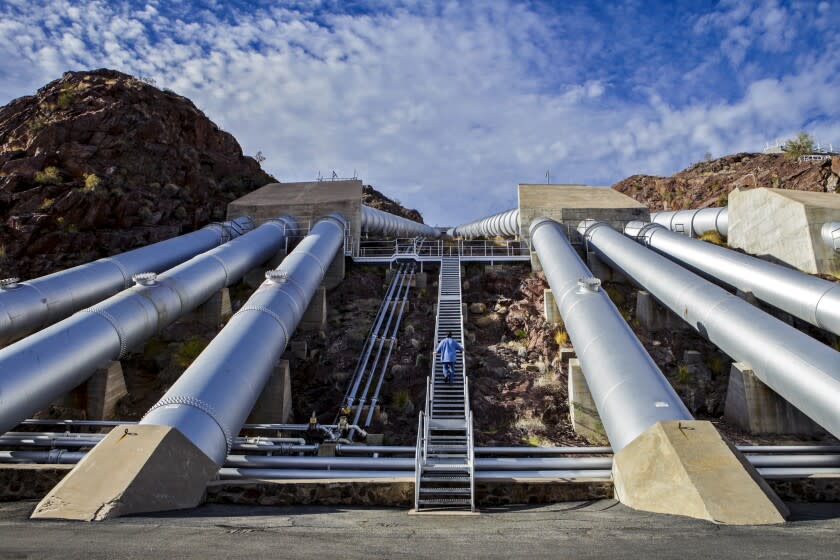Editorial: Yes, Southern California, we have a water shortage emergency too

- Oops!Something went wrong.Please try again later.
So Southern Californians didn’t decrease their water usage in July, despite Gov. Gavin Newsom’s request for a voluntary 15% cutback?
Well, of course not. The dusty lake beds, the dry spigots, the serious water-use cutback orders and the most frightening wildfires (so far, anyway) have been in Northern California, and that’s where Newsom focused his most dire warnings. He declared a drought emergency in Mendocino and Sonoma counties in April, expanded it to 41 counties in May, and then to 50 counties in July — but not Los Angeles, Orange, Ventura, San Diego, Riverside or San Bernardino counties. The Metropolitan Water District of Southern California warned of unprecedented shortages in Lake Mead and has launched an advertising campaign calling for increased conservation. But the MWD is the victim of its own success, in that it has done a superb job over the decades supplying enough water so that residents generally don't think about shortages.
The MWD board declared a water supply alert in August, which was supposed to be followed by local drought ordinances. But cities have had other things on their minds.
Over the course of an extremely hot summer, amid the fear and deprivation caused by the second year of a deadly pandemic and at a time when police officers and others won’t get potentially lifesaving vaccines unless forced to, if even then, a polite request for a modest and fully voluntary 15% cutback in water use sounds an awful lot like, “Don’t worry, be happy.”
In fact, the water outlook for Southern California is alarming. In addition to the puny allocations that urban areas are getting this year from the State Water Project because the Sierra snowpack and the summer runoff failed to fully materialize, Los Angeles and neighboring counties face the first-ever shortage declaration on our other primary water source, the Colorado River. That’s got nothing to do with the Sierra and everything to do with a 21-year drought in Arizona, New Mexico, Colorado, Wyoming, Utah and Nevada — the states from where Southern Californians get much of their water.
In fact, the dry conditions in the Sierra, the Rockies and in between may not be a drought at all, but rather a reversion to historical patterns, following the unusually wet period in which the region was settled and developed. At the same time, global climate change caused by industrial and day-to-day carbon emissions monkeys with the pattern, meaning that when the rain and snow do come, they arrive less predictably. Ever-hotter temperatures cause snowcaps to just evaporate, or else to be soaked into parched mountainsides rather than running down rivers to replenish our supplies.
So we do have a water shortage emergency in Southern California, same as the rest of the state, whether the governor and the MWD have declared it or not. Cutbacks, voluntary so far, will no doubt soon become mandatory.
But we’re going to need better guideposts than something amorphous like 15% off last year's usage.
A better approach would be to ban watering lawns, as in previous emergencies, or — given the fact that dry conditions are here to stay — ripping out lawns entirely, as was done at many homes during the 2012-2016 "drought," which, truth be told, was probably part of a new arid norm that is still with us despite a couple of intervening flood years.
Can we continue building new homes and adding new people in such an environment?
We can, and we should. In fact, laws that encourage construction of multifamily housing provide living quarters, without thirsty yards, for a workforce that otherwise might be seeking traditional housing and putting in new lawns instead of ripping out old ones. We call it “drinking water,” but in fact the greatest single use of household water in California is for landscaping. Apartments, fourplexes and other multifamily units, in which numerous people share landscaping, are quite water thrifty.
So we should pave over our yards?
Not at all. Homeowners have many options for native plants and other landscaping that look lovely and need far less water. And besides, planted yards (peppered with swales, or lower areas in which rainwater and runoff can gather) help direct water into the ground, where we want it, instead of out to sea. In much of the San Fernando Valley, water that soaks into the ground replenishes an enormous aquifer — almost an underground lake — which will likely be our salvation as dry times linger.
There’s no cause for shame over the region’s poor July water savings. We’re just getting started. We’ll need clearer guidelines from our political and water supply leaders, and more emphatic statements about our situation. We can live well on the water we’ve got, if only we respect its scarcity and its value.
This story originally appeared in Los Angeles Times.
